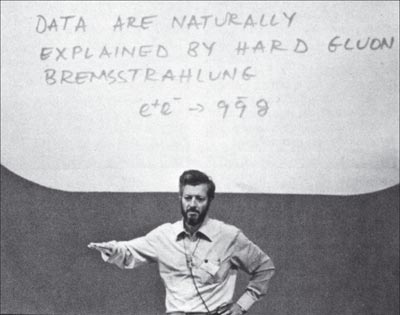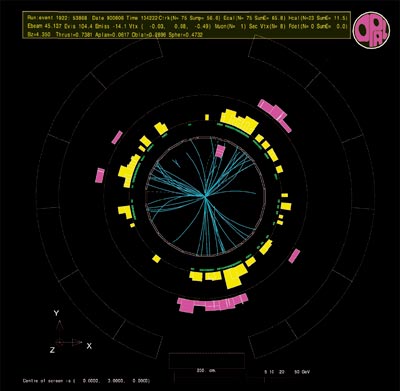John Ellis recalls how theorists and experimentalist friends worked together to find the second gauge boson.

In the mid-1970s quantum chromodynamics (QCD) was generally referred to as the “candidate” theory of the strong interactions. It was known to be asymptotically free and was the only plausible field-theoretical framework for accommodating the (approximate) scaling seen in deep-inelastic scattering, as well as having some qualitative success in fitting the emerging pattern of scaling violations. Moreover, QCD could be used to explain qualitatively the emerging spectrum of charmonia and had some semi-quantitative successes in calculating their decays. No theorist seriously doubted the existence of the gluon but direct proof of its existence, a “smoking gluon”, remained elusive.
In parallel, jet physics was an emerging topic. Statistical evidence was found for two-jet events in low-energy electron–positron annihilation into hadrons at SPEAR at SLAC, but large transverse-momentum jets had not yet been observed at the Intersecting Storage Rings, CERN’s pioneering proton–proton collider. There, it was known that the transverse-momentum spectrum of individual hadron production had a tail above the exponential fall-off seen in earlier experiments, but the shape of the spectrum did not agree with naive predictions that were based on the hard scattering of quarks and gluons, so rival theories – such as the constituent-interchange model – were touted.
The three-jet idea
This was the context in 1976 when I was walking back over the bridge from the CERN cafeteria to my office one day. As I turned the corner by the library, it occurred to me that the simplest experimental situation to search directly for the gluon would be through production via bremsstrahlung in electron–positron annihilation. Two higher-energy collider projects were in preparation at the time, PETRA at DESY and PEP at SLAC, and I thought that they should have sufficient energy to observe clear-cut three-jet events. My theoretical friends Graham Ross, Mary Gaillard and I then proceeded to calculate the gluon bremsstrahlung process in QCD, demonstrating how it would manifest itself via jet broadening and the appearance of three-jet events featuring the long-sought “smoking gluon”. We also contrasted the predictions of QCD with a hypothetical theory based on scalar gluons.
I was already in contact with experimentalists at DESY, particularly my friend the late Bjørn Wiik, who shared my enthusiasm about the three-jet idea. Soon after Mary, Graham and I had published our paper, I made a trip to DESY to give a seminar about it. The reception from the DESY theorists of that time was one of scepticism, even hostility, and I faced fierce questioning on why the short-distance structure of QCD should survive the hadronization process. My reply was that hadronization was expected to be a soft process involving small exchanges of momenta and that two-jet events had already been seen at SPEAR. At the suggestion of Bjørn Wiik, I also went to Günter Wolf’s office to present the three-jet idea: he listened much more politely than the theorists.
The second paper on three-jet events was published in 1977 by Tom Degrand, Jack Ng and Henry Tye, who contrasted the QCD prediction with that of the constituent-interchange model. Then, in 1978, George Sterman and Steve Weinberg published an influential paper showing how jet cross-sections could be defined rigorously in QCD with a careful treatment of infrared and collinear singularities. In our 1976 paper we had contented ourselves with showing that these were unimportant in the three-jet kinematic region of interest to us. Sterman and Weinberg opened the way to a systematic study of variables describing jet broadening and multi-jet events, which generated an avalanche of subsequent theoretical papers. In particular, Alvaro De Rújula, Emmanuel Floratos, Mary Gaillard and I wrote a paper showing how “antenna patterns” of gluon radiation could be calculated in QCD and used to extract statistical evidence for gluon radiation, even if individual three-jet events could not be distinguished.
Meanwhile, the PETRA collider was being readied for high-energy data-taking with its four detectors, TASSO, JADE, PLUTO and Mark J. I maintained regular contact with Bjørn Wiik, one of the leaders of the TASSO collaboration, as he came frequently to CERN around that time for various committee meetings. I was working with him to advocate the physics of electron–proton colliders. He told me that Sau Lan Wu had joined the TASSO experiment and that he had proposed that she prepare a three-jet analysis for the collaboration. She and Gus Zobernig wrote a paper describing an algorithm for distinguishing three-jet events, which appeared in early 1979.
Proof at last
During the second half of 1978 and the first half of 1979, the machine crews at DESY were systematically increasing the collision energy of PETRA. The first three-jet news came in June 1979 at the time of a neutrino conference in Bergen. The weekend before that meeting I was staying with Bjørn Wiik at his father’s house beside a fjord, when Sau Lan Wu arrived over the hills bearing printouts of the first three-jet event. Bjørn included the event in his talk at the conference and I also mentioned it in mine. I remember Don Perkins asking me whether one event was enough to prove the existence of the gluon: my tongue-in-cheek response was that it was difficult to believe in eight gluons on the strength of a single event!

Image credit: OPAL Collaboration.)
The next outing for three-jet events was at the European Physical Society conference in Geneva in July. Three members of the TASSO collaboration, Roger Cashmore, Paul Söding and Günter Wolf, spoke at the meeting and presented several clear three-jet events. The hunt for gluons was looking good!
The public announcement of the gluon discovery came at the Lepton/Photon Symposium held at Fermilab in August 1979. All four PETRA experiments showed evidence: Sam Ting’s Mark J collaboration presented an analysis of antenna patterns; while JADE and PLUTO followed TASSO in presenting evidence for jet broadening and three-jet events. One three-jet event was presented at a press conference and a journalist asked which jet was the gluon. He was told that the smart money was on the left-hand one (or was it the right?). Refereed publications by the four collaborations soon appeared and the gluon finally joined the Pantheon of established particles as the first gauge boson to be discovered after the photon.
An important question remained: was the gluon a vector particle, as predicted by QCD, or was it a scalar boson? In 1978 my friend Inga Karliner and I wrote a paper that proposed a method for distinguishing the two possibilities, based on our intuition about the nature of gluon bremsstrahlung. This was used in 1980 by the TASSO collaboration to prove that the gluon was indeed a vector particle, a result that was confirmed by the other experiments at PETRA in various ways.

Gluon-jet studies have developed into a precision technique for testing QCD. One-loop corrections to three-jet cross-sections were calculated by Keith Ellis, Douglas Ross and Tony Terrano in 1980 and used, particularly by the LEP collaborations, to measure the strong coupling and its running with energy. The latter also used four-jet events to verify the QCD predictions for the three-gluon coupling, a crucial consequence of the non-Abelian nature of QCD.
In the words of Mary Hopkin’s song in 1968, “those were the days, my friends”. A small group of theoretical friends saw how to discover the gluon and promptly shared the idea with some experimental friends, who then seized the opportunity and the rest – as the saying goes – is history. To my mind, it is a textbook example of how theorists and experimentalists, working together, can advance knowledge. The LHC experiments will be a less intimate environment but let us hope that strong interactions between theorists and experimentalists will again lead to discoveries for the textbooks!








